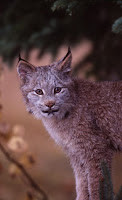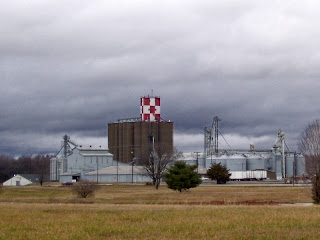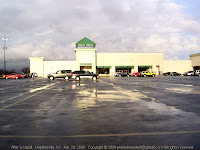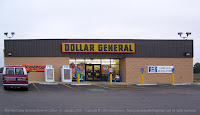Wild cats amongst us
NOTE: If you're seeking information about photos of a big cougar killed on a Trigg County, KY, highway, the e-mail is a hoax. That big cat has been the star of so many bogus e-mails that it has finally been listed by Snopes.com. Also see the March 10, 2008, Kentucky New Era story: "Mountain Lion Exists Only in Hoax," (subscription required). I hope you enjoy reading this article anyway, though.
Dennis has been watching a show about big cats in the U.S. this morning. To be specific, he's watching a "
Monster Quest"show about unexplained repeated sightings of black cats that are several times larger than large domestic cats.
MonsterQuest: Lions in the Backyard
Airs on Monday January 21 04:00 PM
Mountain lions do occasionally attack humans, and when they do it makes headlines across the country. However, it has been reported that people are seeing something else--attacks by large black cats. Pictures and law enforcement encounters prove a big black cat is out there, while it resembles a mountain lion, there is no such thing as a black mountain lion. From Texas to Minnesota to West Virginia, follow the eyewitness accounts and physical evidence of these demon cats. Bones from a carcass that eyewitnesses claim was a huge black cat will be put to the DNA test. One-part history, one-part science and one part monsters discover the truth behind legendary monsters.
Source: Upcoming episodes of Monster Quest on the History Channel
It's been an interesting show. Many of the photographs and videos can be explained or dismissed, but a few cannot. At the end of the show, the bones of the "cat" turn out to be a domestic dog. The official verdict is that most of the "big black cats" are mis-identified bears, dogs, or housecats. A few might be exotic cats, escaped or released from private zoos. Of course, these explanations do not satisfy those who have actually seen the big black cats.
Big cats in northern Nebraska during my childhood

When I was growing up in north-central Nebraska, there were reports of mountain-lion sightings from time to time. Usually, the big cat was observed in or near the wooded canyons of a river or creek.
I am sure that some of the reports were true. The mountain lion (


also known as cougar, panther, or
puma) was once native to Nebraska. Plenty of suitable habitat could still be found in northern Nebraska in the 1950s and 1960s (and still can be found today.) The Nebraska Game and Parks Commission has recently confirmed the
return of the mountain lion to Nebraska -- even
in and around Omaha, as reported by the
Plains Feeder in 2005!
In my childhood, every now and then someone would shoot a bobcat, usually around a canyoned area. Maybe the bobcat was bothering the livestock -- or at least, the rancher was worried that the bobcat
might bother the livestock. I think I remember a few photos in the newspaper of dead bobcats laid out in the back of someone's pickup truck. They may have been trophies of an official bobcat hunting season, and I didn't realize it.
Mountain Lions Around Kansas City
My husband grew up near the Missouri River in Independence, Missouri. When he was little, many stories were told of mountain lions along the river, but none of them were ever proven.
Then, about ten years ago, when the Missouri River had a major flood, many reports were made that mountain lions had been spotted in the residential areas near the river. As I recall, a policeman even reported seeing a mountain lion in a little field within Independence.
After so many unconfirmed sightings through the years, many people felt vindicated when
a mountain lion was hit and killed on the Interstate in the greater Kansas City area. Even the Missouri Conservation Department has finally admitted that there's
evidence of a growing mountain lion population in Missouri.
Bobcats and Cougars in Christian County, Kentucky
Here in Christian County, Kentucky, we occasionally have
reports of mountain lions. Of course, they are never confirmed. We have large areas of rough, wooded hills and plenty of streams, especially in northern Christian County. Our over-abundance of deer would be attractive to big cats, so I don't arbitrarily dismiss mountain lion stories.
I can testify that there are bobcats (
Lynx rufus fasciatus) here, because I've seen two of them. One time, we were visiting a neighbor who lives near Pilot Rock. As we stood outside his house, a large bobcat crossed the field in front of us, several hundred yards away.

Our neighbor pointed out the bobcat. It was well camouflaged in the tall dry grass, and I probably wouldn't have noticed it, on my own. He commented that he saw that bobcat frequently. I don't know how he knew it was the same one!
It is interesting to note that a couple hundred acres around this neighbor's house was in the CRP (Conservation Reserve Program) so it hadn't been used for crops or livestock in a decade or more. The property also includes a creek that runs through a rocky ravine and associated woodlands.
About six or seven years ago, a bobcat ran in front of my car as I drove home from work one dark winter night. I was caught by surprise, and I couldn't imagine what it was! I knew it wasn't a fox or a coyote.
Just a day later, someone brought a stuffed bobcat into the office for my boss. When I saw it, I immediately recognized the animal that had crossed my headlights. I should have known it was a bobcat, but it was a lot smaller than I had expected.
I suspect that I once heard a bobcat in the ravine that lies between our house and the highway below us. One hot summer night about midnight, I went outside to enjoy the cool night breeze that always wafts up from the valley below us.
As I sat there in the dark, listening to the tree frogs and cicadas, I heard a wild scream from the ravine. It was a little unsettling, so I went in the house and went to bed. It may have been a screech owl, but it sounded like a cat to me.
Related:
PDF map of confirmed mountain lion sightings in Nebraska, 1991-2007
US map: Confirmed sightings of cougars outside their established range, 1990-present
Website that lists "Alien Big Cats" around the world


















 also known as cougar, panther, or
also known as cougar, panther, or 





 I have a helpful hint for anyone who wants to avoid weight gain over the winter holidays. It's a simple hint, but I swear that it worked for me
I have a helpful hint for anyone who wants to avoid weight gain over the winter holidays. It's a simple hint, but I swear that it worked for me to be sold.
to be sold.






